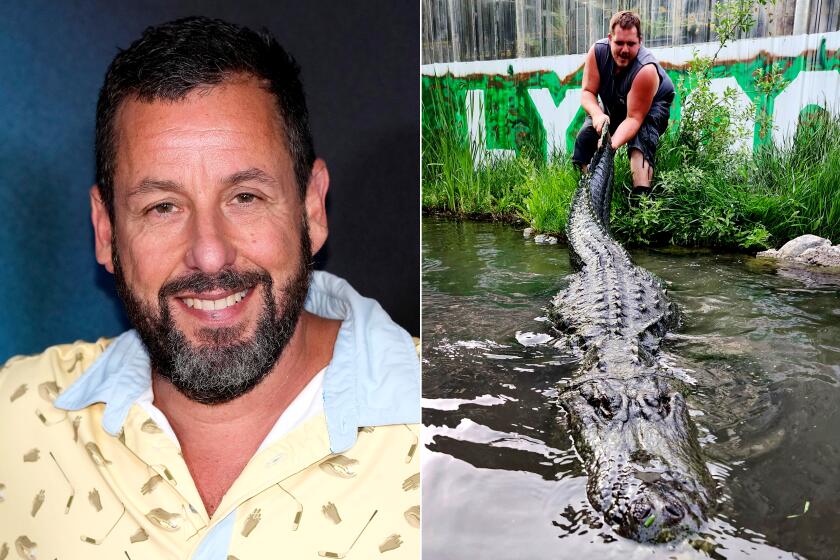Movie review: ‘The Girl Who Played With Fire’
- Share via
Lisbeth Salander, the punked, pierced, dragon-tattooed heroine of Stieg Larsson’s international bestselling Millennium trilogy, is back on the high wire in “The Girl Who Played With Fire,” locked in an ever more treacherous game with villains more depraved, mysteries much murkier and family ties more dark keeping things twisted and taunt.
Though the thriller is in the hands of a different filmmaking team this time led by Swedish director Daniel Alfredson and screenwriter Jonas Frykberg, they’ve kept the searing intelligence and ruthless bent that turned the first book’s adaptation, “The Girl With the Dragon Tattoo,” into an international box office hit and having a strong run in the States, still in theaters four months after its release.
Most importantly, though, the franchise’s secret weapon is back with brilliant young Swedish actress Noomi Rapace again channeling the alienated, unwilling to be broken tough chick that Larsson envisioned and Rapace imbues with such eerie authenticity. Veteran actor Michael Nyqvist returns too as the serious, and seriously sensual journalist, Mikael Blomkvist, who continues to be as intrigued by the enigmatic Lisbeth as the rest of us.
In a smart move, the filmmakers have stripped the dense complications of Larsson’s plotting and sprawling cast of characters down to the bare essentials to focus almost exclusively on Lisbeth’s current travails. For all the delicious pleasure to be found in the juicy side stories that have kept fans worldwide enthralled, they serve the book, not the film and “The Girl Who Played With Fire” is stronger for their loss.
With Lisbeth’s fate hanging by a slender thread as the narrative centerpiece, Alfredson is better able to ratchet up the stakes and deliver a stomach-churning ride as that single life twists in the wind. And ratchet he does.
As the film opens, Lisbeth has slipped back into Stockholm after disappearing for a while into international shadows after the loose ends of “Dragon” were tied up. She’s made some keen investments with money skimmed off the bad guys’ accounts and acquired new digs that will allow her to live there undetected.
Before there is time to wonder why all the secrecy still, her photo is splashed across the tabloids as a suspect in the cold-blooded execution of a freelance writer under contract to Blomkvist’s Millennium magazine. Making matters worse, in an apartment across town, her court-appointed guardian has been blown to bits by the same gun. The murder of the journalist is a mystery, but the other, Nils Bjurman (Peter Andersson) will leave you wondering about Lisbeth’s innocence — she’s been blackmailing him since he raped her months ago, a key plot point in her saga from the start and a notorious scene in the first film so viscerally brutal it had some in the audience heading for the exits.
Just how these murders intersect, and how Lisbeth has been dragged into the mess that somehow also involves the Eastern European sex trade, Swedish state secrets and terrifying psychiatric profiling make up the potboiling puzzle. Alfredson and cinematographer Peter Mokrosinski, who worked together on the 1993 Swedish crime drama, “The Man on the Balcony,” create a tense, moody pallet for Lisbeth to race through as she searches for clues to clear herself and ferret out the man who’s been trying to destroy her since she was a child.
Watching Rapace burrow deep inside Lisbeth’s damaged mind, body and soul is its own sort of twisted pleasure. It is a character fully exposed: the dragon inked from shoulder blades to bum, muscles encasing her body in wiry knots; furtive glances, never holding on a face unless it’s someone she is about to deliver from this life; so vulnerable that it’s heartbreaking when you see it; so slight she should get lost in crowds; holding the screen with the force of those dark undercurrents flowing through her.
The violence, which is a signature of the books and remains a central component of the films, is extreme with faces and bodies bruised and bloodied in ways likely to make you cringe. There are bits from the last film seeded in to fill in some blanks, including a reprise of that notorious rape, but this time we’re spared all but a few frames. Instead, the horror is experienced through Blomkvist’s reaction as he watches the DVD that captured the crime, a technique that might have served the first film as well.
Delivering most of the bone-crunching action in “Fire” is a hulking blond menace named Niedermann (Micke Spreitz), on a rampage unleashed by the nefarious Alexander Zalachenko (Georgi Staykov). There are hints they’ll be back for the final chapter in the fall, a relief since as satisfying as “The Girl Who Played With Fire” is, it leaves you longing for more.
More to Read
Only good movies
Get the Indie Focus newsletter, Mark Olsen's weekly guide to the world of cinema.
You may occasionally receive promotional content from the Los Angeles Times.











